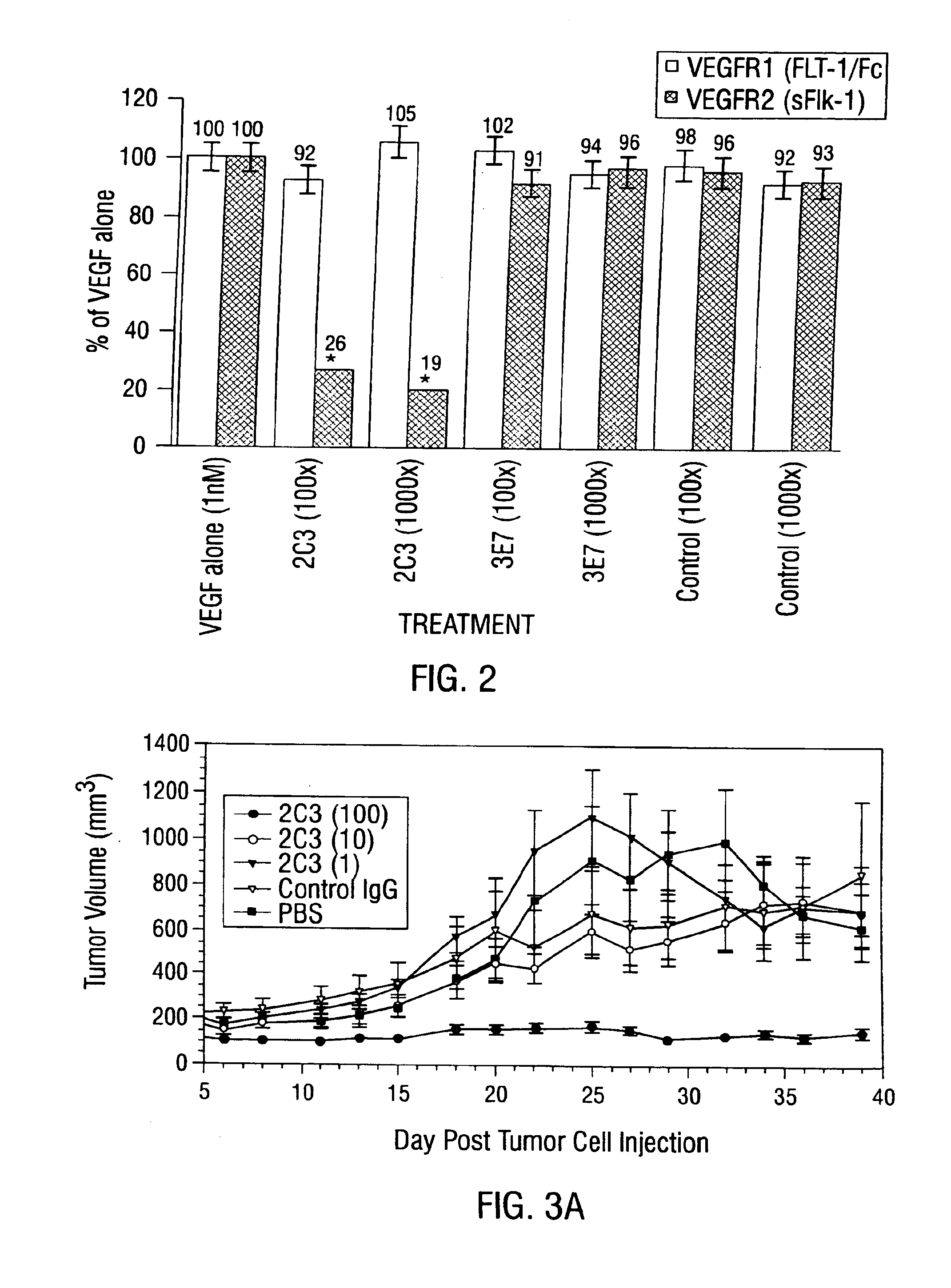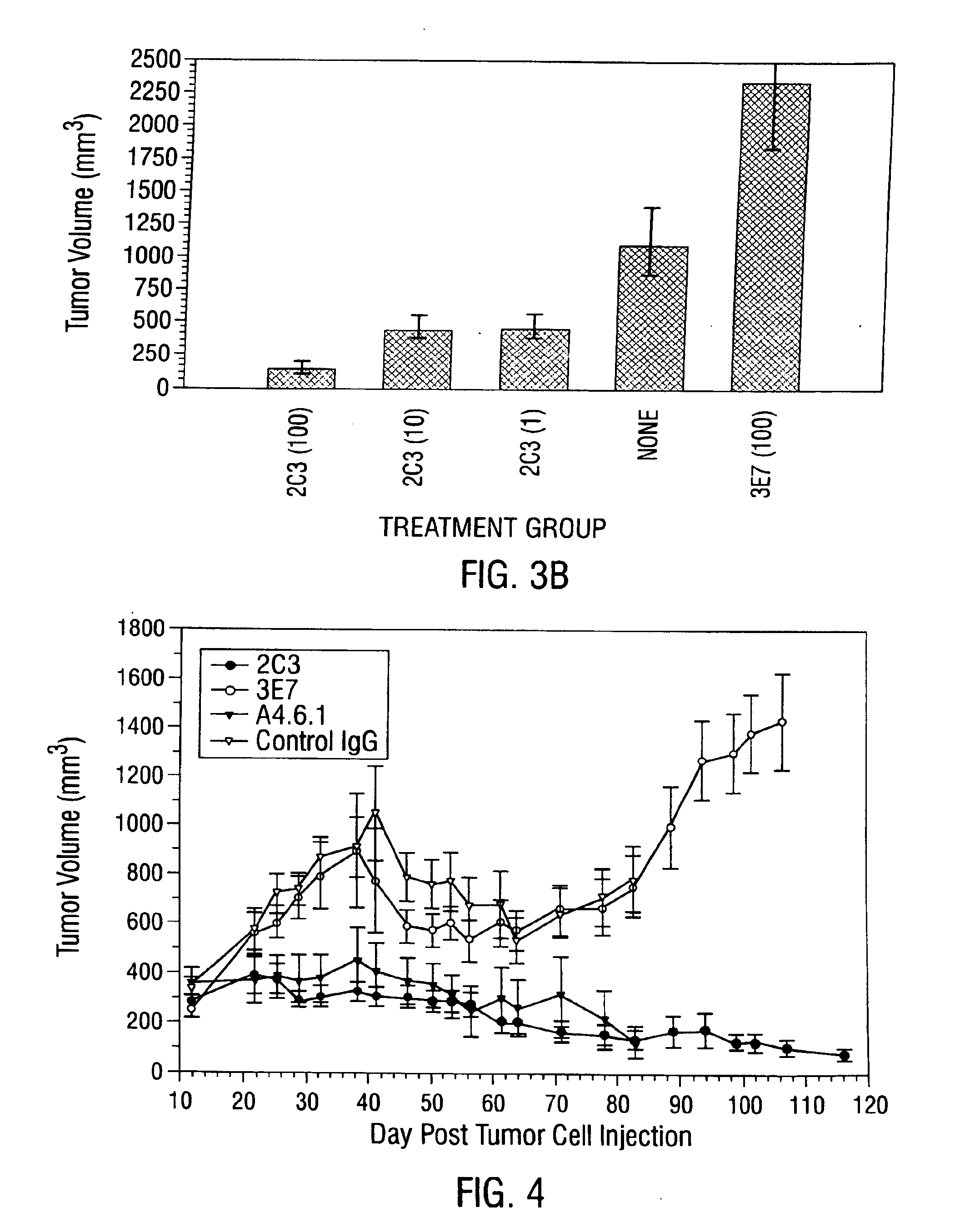Antibody kits for selectively inhibiting VEGF
a technology of antibody kits and vegf, applied in the field of antibody kits, can solve the problems of significant drawbacks of immunotoxin therapy applied to solid tumors, significant distances and interstitial pressure within the tumor, and reduce the binding of labeled antibodies, so as to reduce the binding of control antibodies and effectively compete for binding
- Summary
- Abstract
- Description
- Claims
- Application Information
AI Technical Summary
Benefits of technology
Problems solved by technology
Method used
Image
Examples
example i
Generation and Unique Characteristics of Anti-VEGF Antibody 2C3
A. Materials and Methods
[0859]1. Immunogens
[0860]Peptides corresponding to the N-terminal 26 amino acids of human VEGF (huVEGF; SEQ ID NO:10) and the N-terminal 25 amino acids of guinea pig VEGF (gpVEGF; SEQ ID NO:11) were synthesized by the Biopolymers Facility of the Howard Hughes Medical Institute at UT Southwestern Medical Center at Dallas. The peptides had the following sequences (N to C):
[0861]APMAEGGGQNHHEVVKFMDVYQRSYC; SEQ ID NO:10; and
[0862]APMAEGEQKPREVVKFMDVYKRSYC; SEQ ID NO:11.
[0863]Peptides were conjugated via the C-terminal cysteine to thyroglobulin using succinimidyl 4-(N-maleimidomethyl) cyclohexane-1-carboxylate (SMCC) linker (Pierce, Rockford, Ill.). Control conjugates were also prepared that consisted of L-cysteine linked to thyroglobulin. Conjugates were separated from free peptide or linker by size exclusion chromatography.
[0864]Recombinant human VEGF was also separately used as an immunogen (obtaine...
example ii
2C3 Inhibits Endothelial Cell Migration
A. Materials and Methods
[0913]Endothelial Cell Growth Assay
[0914]Adult bovine aortic endothelial (ABAE) cells were plated into 96-well tissue culture plates at 1500 cells / well and grown in the presence of 0.5 nM human VEGF with the addition of the various sample and control antibodies. Control wells received media with or without VEGF.
[0915]After 4 days of incubation, the cells were quantified by an MTS (3-(4,5-dimethylthiazol-2-yl)-5-(3-carboxylmethoxyphenyl)-2-(4-sulfophenyl)-2H-tetrazolium, inner salt) conversion assay, where MTS conversion to a formazan is proportional to cell number and can be followed by absorbance at 490 nM (Cell Titer 96 AQueous One Solution Cell Proliferation Assay, Promega, Madison, Wis.). The assay was performed according to the manufacturer's instructions.
[0916]Cell growth was estimated by subtracting the MTS conversion in cultures to which VEGF was not added. Results were expressed as a percentage of the MTS conver...
example iii
2C3 Specifically Localizes to Tumors In Vivo
A. Materials and Methods
[0922]In Vivo Localization to Human Tumor Xenografts
[0923]Tumors were grown subcutaneously in immunocompromised mice (NCI-H358 NSCLC in nu / nu mice and HT29 colon adenocarcinoma in SCID mice) until the tumor volume was approximately 1 cm3. 100 μg of unlabeled antibody for studies using SCID mice, or 100 μg of biotinylated antibody for studies using nude mice, was injected intravenously via a tail vein. Twenty four hours later, the mice were anesthetized, perfused with PBS, and tumor and organs including heart, lungs, liver, kidneys, intestines and spleen were collected and snap frozen in liquid nitrogen.
[0924]The tumor and organs from each mouse were sectioned on a cryostat and stained for antibody immunohistochemically as above, with the exception that sections from the nude mice were developed using peroxidase labeled streptavidin-biotin complex (Dako, Carpinteria, Calif.) and the sections from the SCID mice were d...
PUM
| Property | Measurement | Unit |
|---|---|---|
| Electric potential / voltage | aaaaa | aaaaa |
| Composition | aaaaa | aaaaa |
| Viscosity | aaaaa | aaaaa |
Abstract
Description
Claims
Application Information
 Login to View More
Login to View More - R&D
- Intellectual Property
- Life Sciences
- Materials
- Tech Scout
- Unparalleled Data Quality
- Higher Quality Content
- 60% Fewer Hallucinations
Browse by: Latest US Patents, China's latest patents, Technical Efficacy Thesaurus, Application Domain, Technology Topic, Popular Technical Reports.
© 2025 PatSnap. All rights reserved.Legal|Privacy policy|Modern Slavery Act Transparency Statement|Sitemap|About US| Contact US: help@patsnap.com



